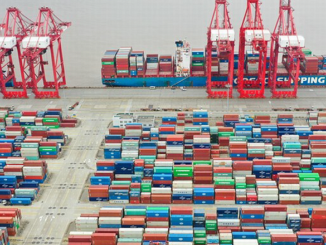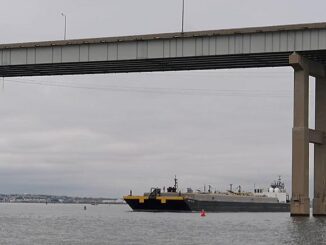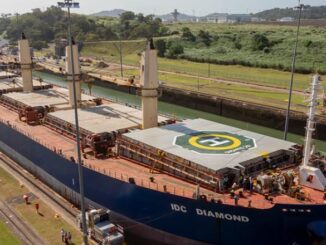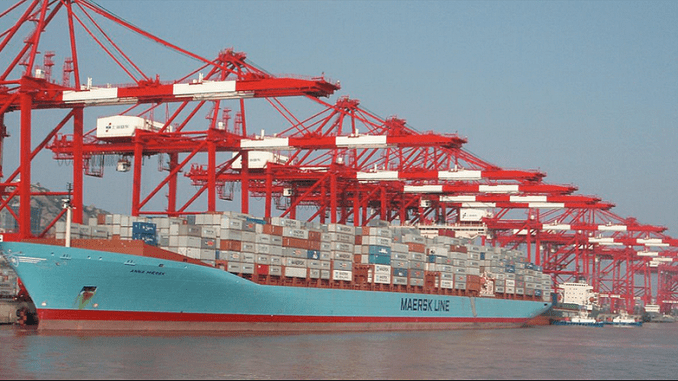
LOS ANGELES, California, February 10, 2022 (ENS) – Los Angeles and Shanghai have initiated a partnership of cities, ports, shipping companies, and cargo owners in China and the United States to create a first-of-its-kind green shipping corridor across the Pacific Ocean on one of the world’s busiest container shipping routes.
The Port of Shanghai, which is the world’s busiest port, and the Port of Los Angeles, the world’s 17th busiest, have set a joint goal to begin transitioning to zero-carbon fueled ships by 2030.
Together with international nonprofit C40 Cities, they pledged to reduce greenhouse gas emissions from the movement of cargo throughout the 2020s.
Gene Seroka, executive director, Port of Los Angeles said, “International collaboration is essential to decarbonize global supply chains. We look forward to partnering with the Shanghai Municipal Transportation Commission, the Shanghai International Port Group, leading shipping lines and major cargo owners to reduce greenhouse gas emissions in the maritime supply chain. It’s time to get started on this important work.”
By the end of 2022, the two ports with industry partner shipping lines and cargo owners have committed to deliver an implementation plan for the green shipping corridor outlining exactly how they will decarbonize it. That plan will include deliverables, milestones, and roles for the partnership.
Key decarbonization goals for the Green Shipping Corridor partnership include:
- – The phasing in of low, ultra-low, and zero-carbon fueled ships through the 2020s, with the world’s first zero-carbon trans-Pacific container ships introduced by 2030 by qualified and willing shipping lines.
- – The development of best management practices to help reduce emissions and improve efficiency for all ships using this international trade corridor.
- – Reducing supply chain emissions from port operations, improving air quality in the ports of Shanghai and Los Angeles and adjacent communities.
The City of Shanghai, the City of Los Angeles, the Port of Shanghai, through the Shanghai Municipal Transportation Commission, the Port of Los Angeles and C40 Cities initiated this Green Shipping Corridor partnership.
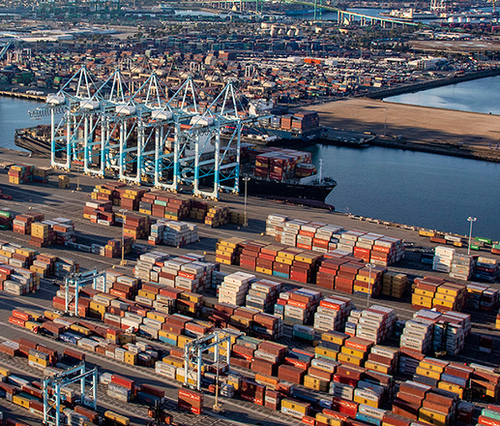
During his tenure as Chair of C40, Mayor of Los Angeles Eric Garcetti launched the C40 Green Ports Forum to decarbonize global supply chains that power our economies, one of his top priorities as Chair. The Port of Los Angeles, under the Mayor’s leadership, has been instrumental in developing the Los Angeles-Shanghai Green Shipping Corridor partnership.
Participating partners include two of the world’s three largest shipping companies: A.P. Moller – Maersk, of France, and CMA CGM, of Denmark.
The Shanghai International Ports Group is a partner along with COSCO Shipping Lines, the Aspen Institute’s Shipping Decarbonisation Initiative, facilitators of Cargo Owners for Zero Emission Vessels (coZEV) and the Maritime Technology Cooperation Centre – Asia.
Mark Watts, executive director of C40 Cities says, “Accelerating efforts to decarbonize the shipping sector is urgent if we are to limit global heating to 1.5°C. By convening international coalitions of the willing and creating a scalable and replicable model for other cities to follow, we hope this ground-breaking green shipping corridor initiative will catalyse action on a global scale.”
Dan Porterfield, President and CEO of the Aspen Institute said, “It is inspiring that the United States and China have come together in this way to address the climate impact of this crucial global industry.”
“Through our Shipping Decarbonisation Initiative and in our role as the facilitator of the Cargo Owners for Zero Emission Vessels initiative, we look forward to working with our partners to help enable the deployment of the first vessels powered by zero life-cycle greenhouse gas emission fuels along this critical shipping route and to making this green corridor project a model of success for the rest of the world,” Porterfield said.
The global shipping industry is responsible for three percent of global greenhouse gas emissions. Worldwide, greenhouse gas emissions from the shipping industry are expected to double by 2050.
Establishing green shipping corridors is critical to enabling the early adoption of long-term decarbonization solutions for international shipping, especially along major routes.
The trans-Pacific corridor is the busiest container shipping lane globally. In 2020, ships using this corridor moved 31.2 million 20-foot equivalent unit containers – 21 percent of the world’s total – across the Pacific Ocean, according to the United Nations Conference on Trade and Development in 2021.
The World Shipping Council supports decarbonization and has identified six regulatory and economic pathways to reach that goal, all of which are critical for the nations of the UN International Maritime Organization, IMO, to address for a successful maritime energy transition.
One pathway is the Green Corridors Programme to accelerate an equitable fuel and technology transition, introducing ships that emit no greenhouse gases and clean fuels across trade lanes where the necessary shoreside energy infrastructure is first available.
In addition, the Council is calling for a controversial solution – a global price on carbon emissions.
“A global price on carbon combined with dependable and broad-based “buy down” programs that effectively level the playing field among newer low and zero GHG ships and the tens of thousands of ships that will still be burning conventional fuels,” the Council says on its website.
A global carbon price, “…will play a large role in making it possible for companies to put zero GHG ships on the water and to operate them competitively.”
John Butler, president & CEO of the World Shipping Council said, “Liner shipping understands the shared responsibility for GHG reductions in the maritime sector, and we don’t underestimate the challenge. We are committed to decarbonizing shipping and have multiple ideas and projects in the pipeline. But to be able make these investments, to take the necessary risks, we – and all other maritime actors – need a regulatory framework that addresses the key strategic issues.”
Butler said, “Action is needed now by the governments of the IMO so as not to stall development but rather to support ambitious innovators and front runners.”
Featured image: A Maersk container ship at Shanghai’s Yangshan Deepwater Port, 2009 (Photo by Tyler Hagerlundt)

